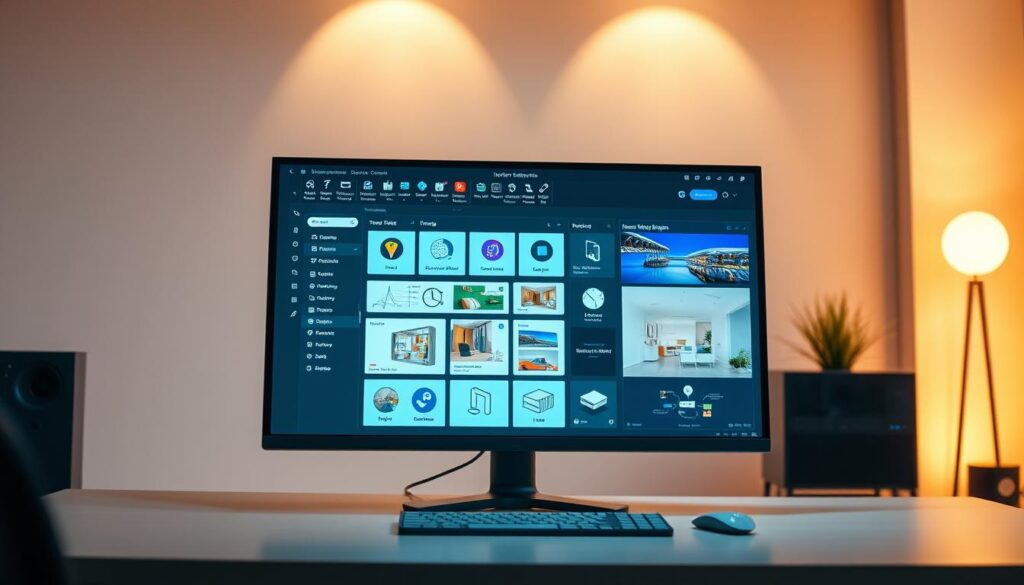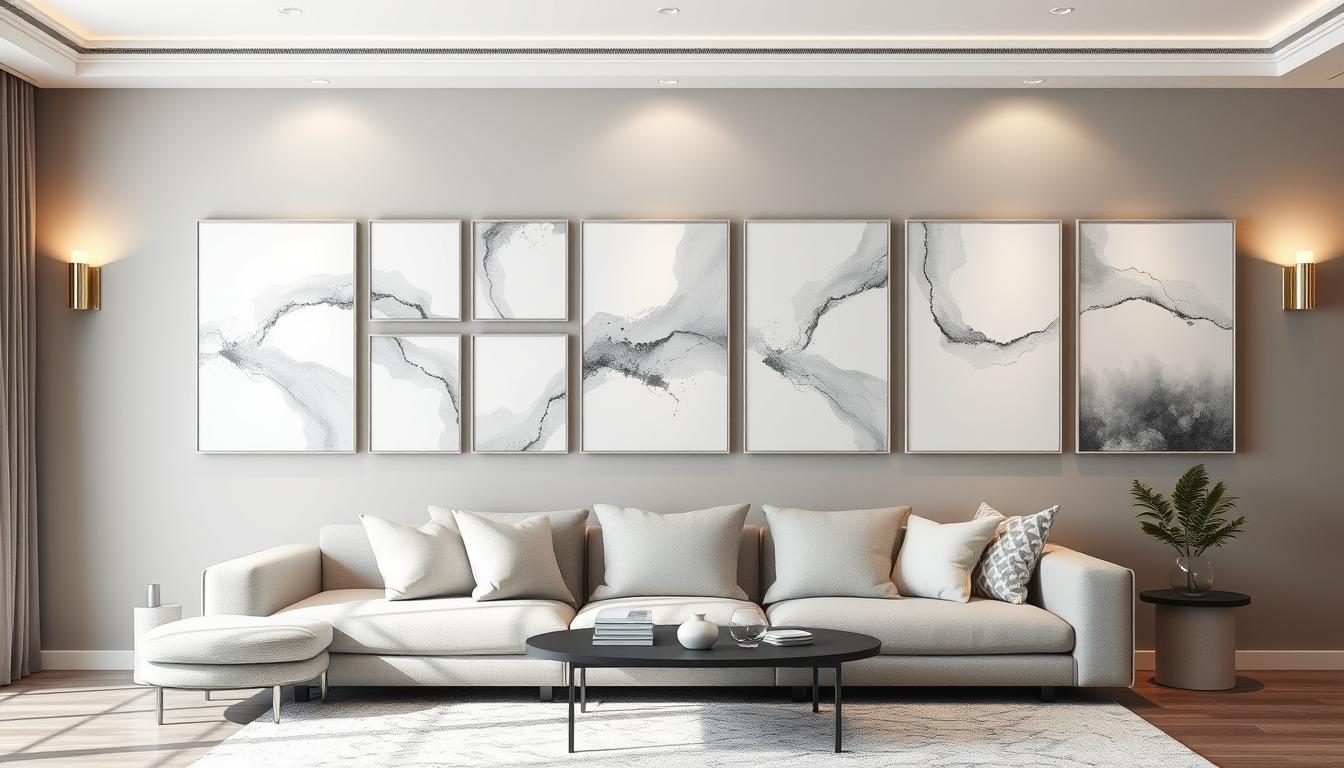Did you know the global interior design market is growing by 5% every year? This is because more homeowners want to make their homes special. They look for tools to help them do this.
Exploring home design means finding the best programs to make our dream homes. With so many choices, picking the right one can be hard.
In this article, we’ll look at the top online interior design programs. They can help us reach our design dreams.
Key Takeaways
- Top-rated home interior design programs for beginners and professionals.
- Key features to consider when choosing a design program.
- Benefits of using online interior design programs for home renovation.
- Popular online interior design programs for 2D and 3D design.
- Tips for getting the most out of your chosen design program.
What are Home Interior Design Programs?
The world of interior design is changing fast. Home interior design programs are leading this change. They teach us the basics of interior design, like space planning and color theory.
Understanding the Basics
Knowing the basics of interior design is key. Home interior design programs teach us about balance and harmony. We learn to use interior design apps and interior decorating software to design spaces.
These programs also cover different design styles. This helps us find our own unique style. With the basics down, we can make spaces that look good and work well.
Importance of Design Education
Design education is crucial. It gives us the skills for a career in interior design or to improve our home decor. Home interior design programs let us practice with professional interior design software.
Design education also lets us learn from experts. We get feedback on our work. This helps us improve and find our own design style.
Types of Home Interior Design Programs
Home interior design programs vary, fitting different learning styles and career goals. It’s important to know the many options available in interior design education.
These programs teach us the skills and knowledge needed to succeed in interior design. From certificates to online courses, each offers unique benefits and meets specific career needs.
Certificate Programs
Certificate programs focus on specific areas like sustainable design or kitchen and bath design. They’re perfect for those wanting to improve in a certain area of interior design.
A sustainable design certificate teaches us about eco-friendly materials and practices. The National Kitchen and Bath Association (NKBA) says sustainable design is now a standard in the industry.
“The key to successful interior design is understanding the needs and preferences of the client, and creating spaces that are both functional and aesthetically pleasing.” –
Associate Degrees
Associate degrees in interior design take two years and cover design basics, color theory, and spatial planning. They prepare students for entry-level jobs.
An associate degree is a good start for newcomers. It mixes theory and practical skills. The American Society of Interior Designers (ASID) notes it can lead to roles like design assistant or junior designer.
Bachelor’s Degrees
Bachelor’s degrees in interior design or related fields take four years. They cover a wide range of topics, from design history to building codes. These programs prepare students for more senior roles.
A bachelor’s degree can lead to roles like project management or senior designer. Some employers prefer or require a bachelor’s degree for certain positions.
Online Courses
Online courses offer flexibility and convenience. They can cover basic design principles to advanced software skills, like AutoCAD or SketchUp.
For example, online courses in virtual interior design tools keep us updated with the latest technology and trends. As digital design evolves, having these skills is very beneficial.
| Program Type | Duration | Focus |
|---|---|---|
| Certificate Programs | Several months to a year | Specialized skills |
| Associate Degrees | 2 years | Foundational knowledge |
| Bachelor’s Degrees | 4 years | Comprehensive education |
| Online Courses | Variable | Flexible, skill-specific |
Factors to Consider When Choosing a Program
When picking a home interior design program, we need to think about several things. The right program can give us the skills and knowledge we need to do well in this field.
Accreditation
Accreditation is key because it shows the program meets industry standards. Look for programs accredited by recognized accrediting agencies like the National Association of Schools of Art and Design (NASAD) or the Council for Interior Design Accreditation (CIDA).
Curriculum and Specializations
The curriculum should cover a wide range of topics. This includes design principles, color theory, and top interior design software like AutoCAD and SketchUp. Specializations, like sustainable design or universal design, can also be helpful.
Location and Convenience
The program’s location is important too. Online courses offer flexibility, while on-campus programs provide face-to-face interaction. We should think about what fits our lifestyle and learning style best.
Cost and Financial Aid
The program’s cost is also a big factor. We need to look at the tuition and other expenses like software and materials. Exploring financial aid options, such as scholarships, grants, and loans, can make the program more affordable.
| Factor | Importance | Considerations |
|---|---|---|
| Accreditation | High | NASAD, CIDA accreditation |
| Curriculum and Specializations | High | Design principles, color theory, top interior design software |
| Location and Convenience | Medium | Online vs. on-campus, flexibility |
| Cost and Financial Aid | High | Tuition, materials, scholarships, grants |
Top Home Interior Design Programs in the United States
In the US, we find top home interior design programs in universities, community colleges, and online. Each offers specializations and curricula to meet different needs and preferences.
Renowned Universities
Prestigious universities in the US are known for their home interior design programs. For example, Cornell University has a program in the College of Human Ecology. Rhode Island School of Design (RISD) is famous for its interior design courses, teaching design principles and practices.
These universities have great faculty, modern facilities, and lots of resources. They’re perfect for those wanting a traditional university experience.
Community Colleges
Community colleges also have valuable home interior design programs, often at a lower cost. The Fashion Institute of Technology (FIT) in New York offers an Associate in Applied Science (AAS) degree in Interior Design. These programs focus on practical skills, helping students get into the workforce or further their education.
Community colleges like FIT offer flexible schedules. This is great for students balancing school with other life commitments.
Online Institutions
Online education has opened up high-quality home interior design programs to everyone. Parsons School of Design at The New School offers online degrees in interior design. They use digital tools and platforms for a full education. Students learn about interior design apps like AutoCAD and SketchUp, preparing them for the industry.
Online interior design programs are flexible and accessible. They let us study without the limits of traditional classrooms.
Looking at different institutions helps us find the right home interior design program for our goals and career.
Benefits of Pursuing Home Interior Design Education
Home interior design education brings many benefits. It helps us develop skills and advance our careers. We learn the basics and advanced techniques of the industry.
Skill Development
One key benefit is learning essential skills. We use professional interior design software like AutoCAD and SketchUp. This helps us create detailed designs and models.
We also learn about space planning, color theory, and materials. These skills are vital for making spaces both functional and beautiful. Interior decorating software lets us see our designs and make changes before they’re built.
Networking Opportunities
Education in home interior design opens doors to networking. We join a community of students and professionals. This lets us meet others, find jobs, and learn from experts.
Networking events and workshops are great for sharing ideas and learning. They help us grow our careers by connecting with others in the field.
Career Advancement
Getting an education in home interior design boosts our careers. With a degree, we stand out in the job market. Our career paths open up.
We can become interior designers, space planners, or even set designers. Room design programs help us turn our ideas into reality. Education prepares us for bigger projects and leadership roles.
| Benefit | Description | Impact |
|---|---|---|
| Skill Development | Learning professional interior design software and interior decorating software. | Enhanced design capabilities and employability. |
| Networking Opportunities | Connecting with industry professionals and peers. | Increased job prospects and collaborations. |
| Career Advancement | Utilizing room design programs and other skills for career progression. | Greater career opportunities and leadership roles. |
Popular Design Software Covered in Programs
Many home interior design programs teach students about industry-standard software. This prepares them for their future jobs. It’s key to learn the tools they’ll use every day.
The software used in these programs is vital. It helps students create detailed designs that clients will love. Some top software includes:
- AutoCAD
- SketchUp
- Revit
AutoCAD
AutoCAD is a top choice for making accurate 2D and 3D drawings. It’s a favorite in architecture and interior design for its precision and flexibility.
Key Features of AutoCAD:
- Advanced drafting tools
- Customization options
- Collaboration features
SketchUp
SketchUp is easy to use and loved by interior designers for its 3D models. It’s great for quickly bringing design ideas to life.
Benefits of SketchUp include:
- User-friendly interface
- Extensive library of models and textures
- Compatibility with other design software
Revit
Revit is a BIM software used more and more in design and construction. It lets users create detailed building models with lots of data.
Revit’s key advantages:
- Integrated design and documentation
- Collaboration and data management
- Analysis and simulation tools
Learning these software tools helps students in home interior design programs. They’re ready to start their careers and do well.

Portfolio Development in Interior Design Programs
In interior design, a portfolio is more than just our work. It shows our style and skills. Portfolio development is key in interior design programs, preparing us for a career.
Importance of a Strong Portfolio
A strong portfolio is vital. It shows our design skills and experience to employers. It acts as a visual resume, showing our abilities and flexibility in interior design.
“A well-crafted portfolio can make a significant difference in securing job opportunities and advancing our career in interior design.”
By showing various projects, we prove our skill in using interior design apps and interior decorating software. Programs often teach us to use tools like AutoCAD and SketchUp.
Tips for Building a Portfolio
Creating a great portfolio takes planning and effort. Here are some tips:
- Include a range of projects to show different styles and techniques.
- Highlight your role in each project, whether alone or with a team.
- Use high-quality images and detailed descriptions to explain your design choices.
- Keep your portfolio current, adding new projects and removing old ones.
- Customize your portfolio for each job application or to showcase your skills.
By following these tips and using resources from interior design programs, we can build a strong portfolio. It will show our value as interior designers effectively.
Career Opportunities After Completing Programs
After finishing online interior design programs, we find many exciting career paths. These programs teach us skills like creativity, technical know-how, and understanding space. This knowledge helps us in various roles that need these qualities.
Exploring different careers, it’s key to know what each role needs. Let’s look at some promising jobs in interior design.
Interior Designer
Interior designers make spaces both functional and beautiful. They use design principles, color theory, and space planning to improve interiors. They work with clients to create designs that fit their needs and tastes.
Some main tasks for interior designers are:
- Meeting with clients to discuss project goals and requirements
- Developing initial design concepts and presenting them to clients
- Selecting materials, finishes, and furniture for the space
- Overseeing the installation of design elements and ensuring the project is completed on time and within budget
Space Planner
Space planners focus on making the most of available space. They work with architects, designers, and others to plan efficiently. This involves analyzing space and creating plans to use it well.
Key skills for space planners are:
- Understanding of spatial relationships and ergonomics
- Proficiency in design software such as AutoCAD and SketchUp
- Ability to communicate effectively with clients and team members
Set Designer
Set designers create the visual world for theater, film, or TV. They work with directors and producers to design sets that match the project’s vision.
Some main tasks for set designers are:
- Reading and interpreting scripts to understand the setting and requirements
- Developing initial design concepts and models
- Collaborating with the production team to ensure the set is built and installed correctly
Looking at these careers, it’s clear that interior design programs open many doors. By using our skills and knowledge, we can find rewarding jobs that challenge us creatively.

Whether we become interior designers, space planners, or set designers, our education sets us up for success. It gives us a strong base for a fulfilling career in the field.
Continuing Education and Certifications
The world of interior design is always changing. This makes it crucial for us to keep learning. New technologies and design trends pop up all the time. It’s important for us to stay up-to-date to give our best to our clients.
Lifelong Learning in Interior Design
Learning for life is key in interior design. It boosts our skills and keeps us in the loop with the latest professional interior design software and top interior design software. Through ongoing education, we can get better at designing and stay ahead in the game.
Some big pluses of lifelong learning are:
- Keeping up with the latest trends and tech
- Learning more about design principles and practices
- Getting better at using interior design apps and software
- Meeting other pros in the field
Certification Programs in Interior Design
Certification shows we’re serious about our work. These programs cover areas like sustainable design or universal design. They really help us stand out.
Some top certification programs are:
- NCIDQ (National Council for Interior Design Qualification) certification
- LEED (Leadership in Energy and Environmental Design) certification
- Certified Interior Designer (CID) certification
Going for these certifications can make us look even better to clients. It also helps us create designs that meet their changing needs.
Conclusion: Finding the Right Fit for Us
Exploring home interior design programs is a big step. We need to think about what we want and need. We’ve looked at different programs, like certificate courses and online options, to help us decide.
Our Path Forward
Choosing the right program is key. We should look at things like accreditation, what the program teaches, and how much it costs. This way, we make sure it matches our career dreams and gives us the skills we need.
Taking the Next Steps
Now, we know what programs are out there. It’s time to move forward. We can start by finding the best programs, talking to design experts, and checking out online options that work for us.



